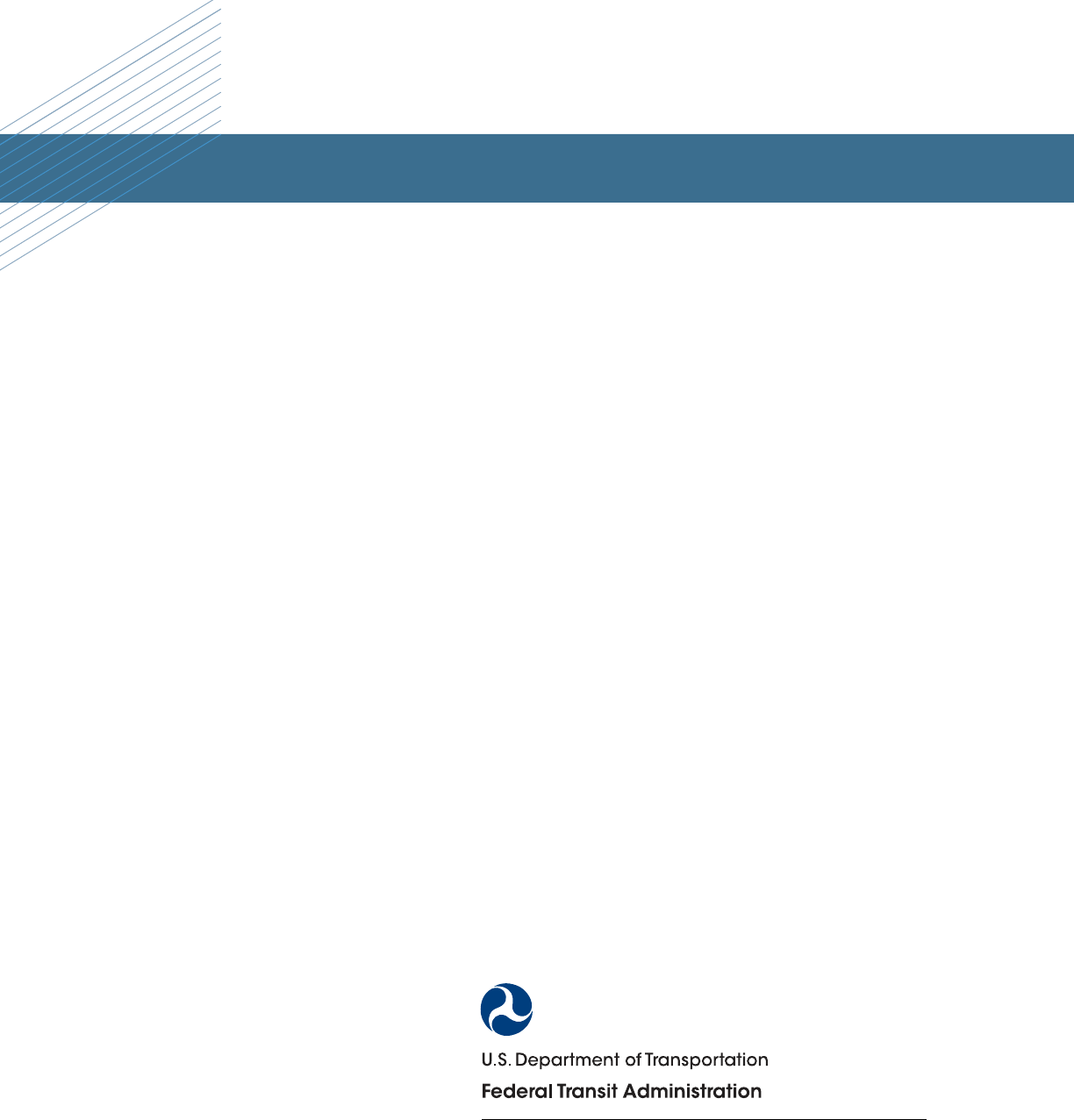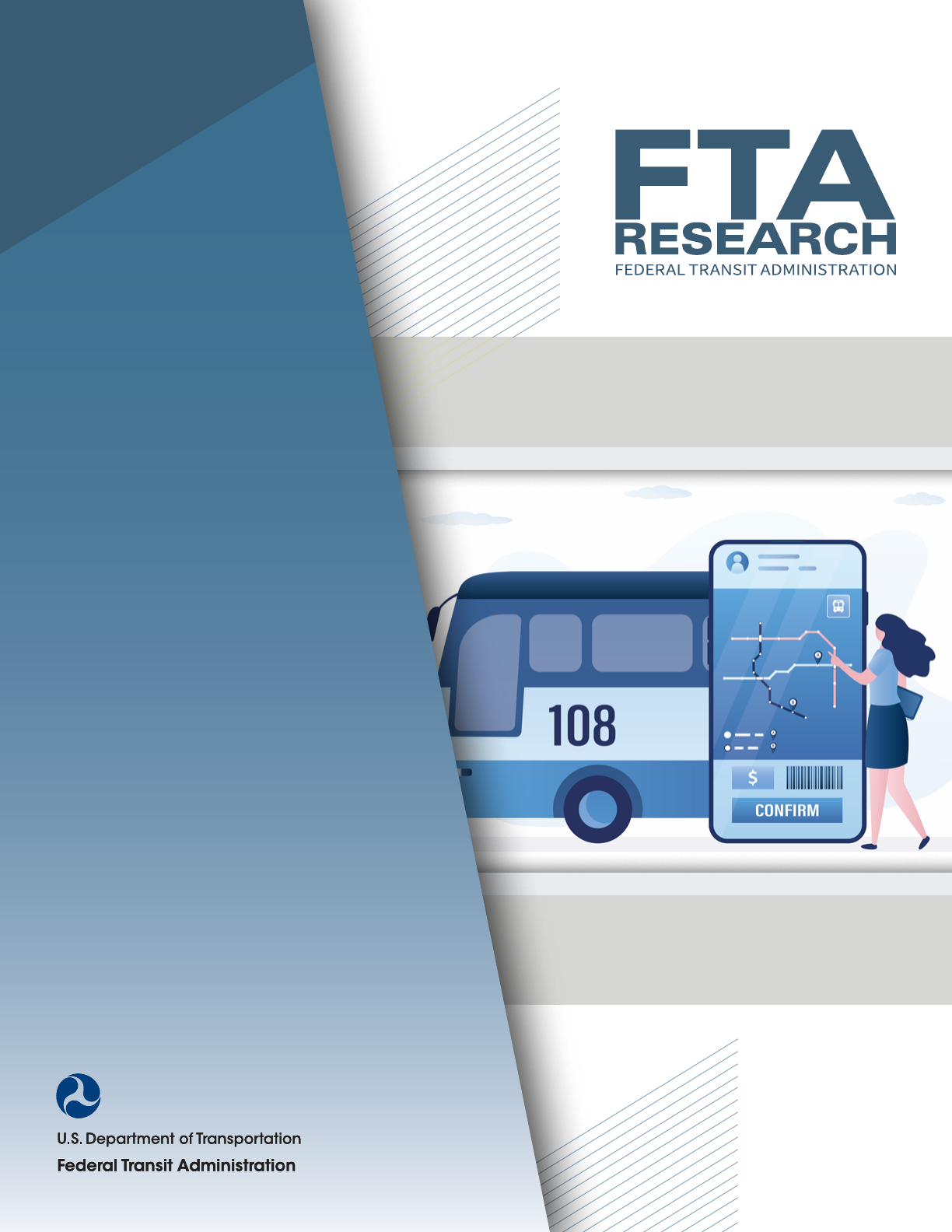
MAY
20
23
FTA Report No. 0245
Location-Based
Service Data for
Transit Agency
Planning and
Operations
Market Scan and
Feasibility Analysis
PREPARED BY
John A. Volpe National Transportation
Systems Center
COVER PHOTO
Courtesy of Adobe Stock # 464958739
DISCLAIMER
This document is disseminated under the sponsorship of the U.S. Department of Transportation in the interest of
information exchange. The United States Government assumes no liability for its contents or use thereof. The United States
Government does not endorse products or manufacturers. Trade or manufacturers’ names appear herein solely because
they are considered essential to the objective of this report. The opinions and/or recommendations expressed herein do
not necessarily reflect those of the U.S. Department of Transportation.

Location-Based Service
Data for Transit Agency
Planning and Operations
Market Scan and Feasibility
Analysis
MAY 2023
FTA Report No. 0245
PREPARED BY
John A. Volpe National Transportation
Systems Center
U.S. Department of Transportation
55 Broadway
Cambridge MA 02142
SPONSORED BY
Federal Transit Administration
Oice of Research, Demonstration and Innovation
U.S. Department of Transportation
1200 New Jersey Avenue, SE
Washington, DC 20590
AVAILABLE ONLINE
https://www.transit.dot.gov/research-innovation/
a-reports-and-publications
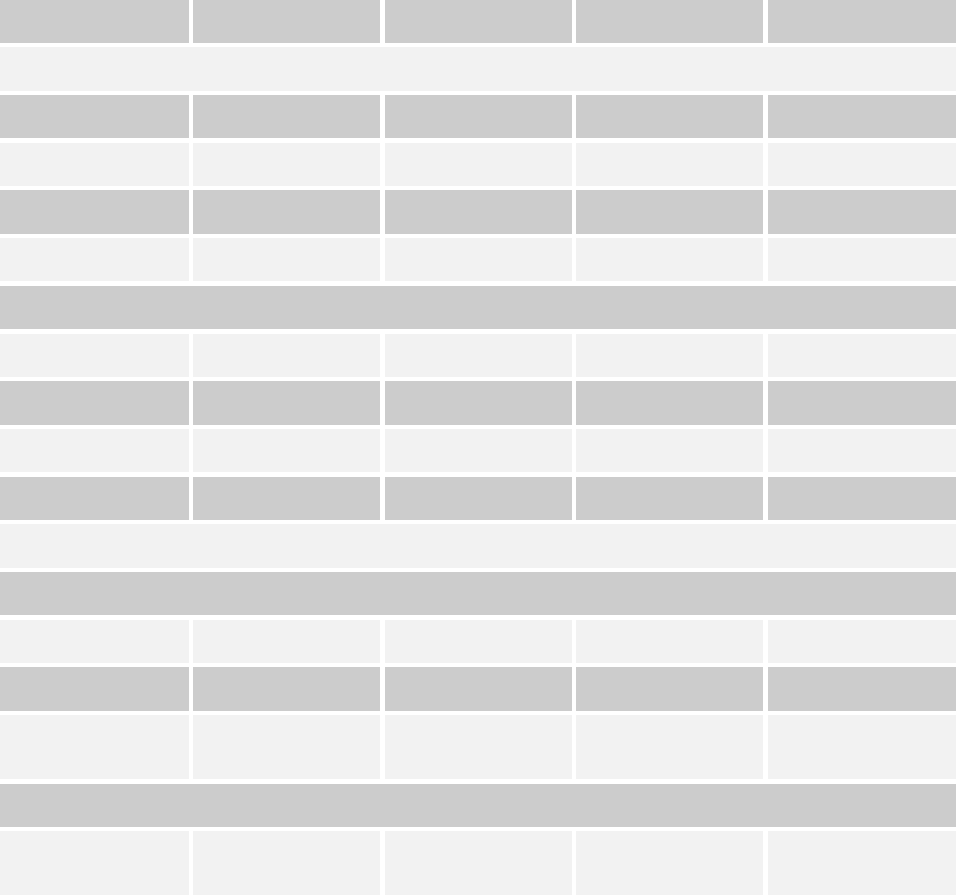
Metric Conversion Table
SYMBOL WHEN YOU KNOW MULTIPLY BY TO FIND SYMBOL
LENGTH
in inches 25.4 millimeters mm
ft feet 0.305 meters m
yd yards 0.914 meters m
mi miles 1.61 kilometers km
VOLUME
fl oz fluid ounces 29.57 milliliters mL
gal gallons 3.785 liters L
ft
3
cubic feet 0.028 cubic meters m
3
yd
3
cubic yards 0.765 cubic meters m
3
NOTE: volumes greater than 1000 L shall be shown in m
3
MASS
oz ounces 28.35 grams g
lb pounds 0.454 kilograms kg
T short tons (2000 lb) 0.907
megagrams
(or "metric ton")
Mg (or "t")
TEMPERATURE (exact degrees)
o
F Fahrenheit
5 (F-32)/9
or (F-32)/1.8
Celsius
o
C
FEDERAL TR ANSIT ADMINISTRATION ii
Metric Conversion Table
Metric Conversion Table

FEDERAL TRANSIT ADMINISTRATION v
REPORT DOCUMENTATION PAGE
Form Approved
OMB No. 0704-0188
1. REPORT DATE
May 2023
2. REPORT TYPE
Final
3. DATES COVERED
September 2021 – January 2023
The public reporting burden for this collection of information is estimated to average 1 hour per response, including the time for reviewing
instructions, searching existing data sources, gathering and maintaining the data needed, and completing and reviewing the collection of
information. Send comments regarding this burden estimate or any other aspect of this collection of information, including suggestions for reducing
the burden, to Department of Defense, Washington Headquarters Services, Directorate for Information Operations and Reports (0704-0188), 1215
Jeerson Davis Highway, Suite 1204, Arlington, VA 22202-4302. Respondents should be aware that notwithstanding any other provision of law, no
person shall be subject to any penalty for failing to comply with a collection of information if it does not display a currently valid OMB control number.
4. TITLE AND SUBTITLE
Location-Based Service Data for Transit Agency Planning and Operations:
Market Scan and Feasibility Analysis
5a. CONTRACT NUMBER
6. AUTHOR(S)
Jingsi Shaw, Lafcadio Flint, and Eric Englin
7. PERFORMING ORGANIZATION NAME(S) AND ADDRESSE(ES)
John A. Volpe National Transportation Systems Center
U.S. Department of Transportation
55 Broadway
Cambridge, MA 02142
8. PERFORMING ORGANIZATION REPORT
NUMBER
FTA Report No. 0245
9. SPONSORING/MONITORING AGENCY NAME(S) AND ADDRESS(ES)
U.S. Department of Transportation
Federal Transit Administration
Oce of Research, Demonstration and Innovation
1200 New Jersey Avenue, SE, Washington, DC 20590
12 . DISTRIBUTION/AVAILABILITY STATEMENT
Available from: National Technical Information Service (NTIS), Springeld, VA 22161; (703) 605-6000, Fax (703) 605-6900,
email [[email protected]v]; Distribution Code TRI-30
14. ABSTRACT
This report provides a primer on location-based service (LBS) data and its uses in public transportation. It denes LBS data, describes the
techniques for collecting and processing the data, and the key parties involved. The report highlights opportunities, limitations, and potential
risks of using LBS data, based on the literature and interviews with transit agencies, data providers, and data privacy experts. Finally, this report
provides recommendations to transit agencies on the prudent, safe, and eective use of LBS data.
15. SUBJECT TERMS
Analysis, Analytics, Data, Data Science, Location-based Services, Innovation, Planning, Privacy
a. REPORT
Unclassified
b. ABSTRACT
Unclassified
17. LIMITATION OF
ABSTRACT
Unlimited
19a. NAME OF RESPONSIBLE PERSON
5b. GRANT NUMBER
5c. PROGRAM ELEMENT NUMBER
c. THIS PAGE
Unclassified
16. SECURITY CLASSIFICATION OF:
18. NUMBER
OF PAGES
41
19b. TELEPHONE NUMBER
Standard Form 298 (Rev. 8/98)
Prescribed by ANSI Std. Z39.18
13. SUPPLEMENTARY NOTES [www.transit.dot.gov/research-innovation/fta-reports-and-publications] [https://www.transit.dot.gov/about/research-
innovation] [https://doi.org/10.21949/1527658] Suggested citation: Federal Transit Administration. Location-Based Service Data for Transit
Agency Planning and Operations: Market Scan and Feasibility Analysis.
Washington, D.C.: United States Department of Transportation, 2022.
https://doi. org/10.21949/1527658.
10. SPONSOR/MONITOR'S ACRONYM(S)
FTA
11. SPONSOR/MONITOR'S REPORT NUMBER(S)
5d. PROGRAM NUMBER
5e. TASK NUMBER
5f. WORK UNIT NUMBER

FEDERAL TRANSIT ADMINISTRATION vi
TABLE OF CONTENTS
1 Executive Summary
3 Section 1 Introduction
8 Section 2 Methodology
10 Section 3 Key Findings
17 Section 4 Feasibility Analysis
24 Section 5 Recommendations
27 Appendix A Stakeholder Interviews
30 Acronyms and Abbreviations
31 References
LIST OF FIGURES
3 Figure 1-1 Passively Collected Mobile Device Data Sources
6 Figure 1-2 LBS Data Ecosystem
7 Table 1-1 Major Data Measures from LBS Data
8 Table 2-1 Major Transportation Planning Documents Reviewed
9 Table 2-2 Agencies Interviewed and Ailiated Role
12 Table 3-1 Major Existing/Proposed LBS Data Use Cases by Interviewed
Transit Agencies
21 Table 4-1 Comprehensive Data Privacy Laws
LIST OF TABLES
FEDERAL TRANSIT ADMINISTRATION vii
Acknowledgments
This report was prepared by the Technology, Innovation, and Policy Division
of the U.S. Department of Transportation (USDOT) John A. Volpe National
Transportation Systems Center under sponsorship from the Federal Transit
Administration (FTA) Oice of Research, Demonstration, and Innovation. The
authors thank the project team from FTA: David Schneider, Ken Cervenka, and
Je Roux. The authors also wish to thank the individuals interviewed for this
report, who oered insights based on their experience in transit agencies across
the country, big and small.
FEDERAL TRANSIT ADMINISTRATION viii
Abstract
This report provides a primer on location-based service (LBS) data and its
uses in public transportation. It defines LBS data, describes the techniques for
collecting and processing the data, and the key parties involved. The report
highlights opportunities, limitations, and potential risks of using LBS data,
based on the literature and interviews with transit agencies, data providers, and
data privacy experts. Finally, this report provides recommendations to transit
agencies on the prudent, safe, and eective use of LBS data.
FEDERAL TRANSIT ADMINISTRATION 1
Executive Summary
Anonymized and aggregated data from smart phones and other location-
aware devices can be used to infer information about people’s travel patterns,
including trip origins and destinations, modes of transportation, when trips
occurred, and overall travel times. However, most transit agencies continue
to rely on more traditional methods, such as automated passenger counter
(APC) devices, automated fare collection (AFC), ridership surveys, and census
data, to analyze travel patterns and identify potential transit riders. During
the pandemic, many transit agencies found that traditional data could not
quickly or accurately capture the disruptive impacts on ridership and are
exploring location-based service (LBS) data as a novel tool to better understand
travel patterns and travel demand going forward. This report summarizes the
experiences of transit agencies using LBS data to improve transit operations and
planning, lessons learned, key challenges and risks.
Through interviews and information reviewed, this report identifies the
following key findings:
• Transit agencies have found promising use cases for LBS data, including
bus network redesign, improving bus operations, understanding mode
share and complete trips, emergency response, prioritizing investment,
and outreach/marketing. Bus network redesign is the most common use
case among all the interviewed agencies.
• Transit agencies work closely with data vendors to improve LBS data and
explore how to use the data to guide decision making. The agencies work
with aggregated information that data vendors process and generate
based on raw LBS data. None of the agencies used disaggregated data due
to three main reasons: 1) state data privacy laws, 2) privacy concerns, and
3) technical challenges associated with making sense of the data.
• Transit agencies may find the greatest success if they use LBS data to
supplement existing data streams and take steps to “ground truth” results.
• Although no transit agencies reported any privacy concerns raised by the
public, transit agencies are aware of LBS data-related privacy concerns.
• The data used by vendors may change as novel data sources used to
examine spatial and temporal patterns become available.
Transit agencies, industry experts, and privacy advocates caution that LBS
data comes with limitations: time and expertise are required to process and
interpret the information eectively; accuracy may be diicult to verify; some
demographic groups may be underrepresented, and LBS data raises concerns
about potential violations to individual privacy and civil liberties. While LBS data
have many constructive potential uses, it should also be used prudently and
safely. The report identifies the following key questions and recommendations:
FEDERAL TRANSIT ADMINISTRATION 2
EXECUTIVE SUMMARY
How can a transit agency tell if LBS is the right tool?
• Network with early adopters to identify lessons learned and determine
how transit agencies use LBS data and what it takes to successfully use LBS
data to support the needs of transit agencies.
• Evaluate internal technical capacity and consider partnerships with
state departments of transportation (DOTs), metropolitan planning
organizations (MPOs), and academia to share insights and use the data
eectively. Consider conducting a pilot or trial before entering a long-term
contract.
What precautions can agencies take when working with LBS data?
• Develop methods to “ground truth” LBS data and seek to understand
vendor data aggregation and analytical methodologies to the greatest
extent possible.
• Establish strong internal controls for data management and privacy
protection and be prepared to answer questions from the public on data
bias and privacy.
• Stay abreast of ongoing technological and legal changes.
Transit agencies using LBS data should treat it as one investment in a portfolio
of many transit data products. LBS is an emerging data source for most transit
agencies and excitement about its potential for new insights should be balanced
with a healthy skepticism. If used wisely, LBS data can be a useful tool in a
transit agency’s analytic toolbox. Transit agencies should pay attention to the
changing landscape for tools or data sources that can be used to understand
people’s movements and activities without security, legal, or ethical concerns.
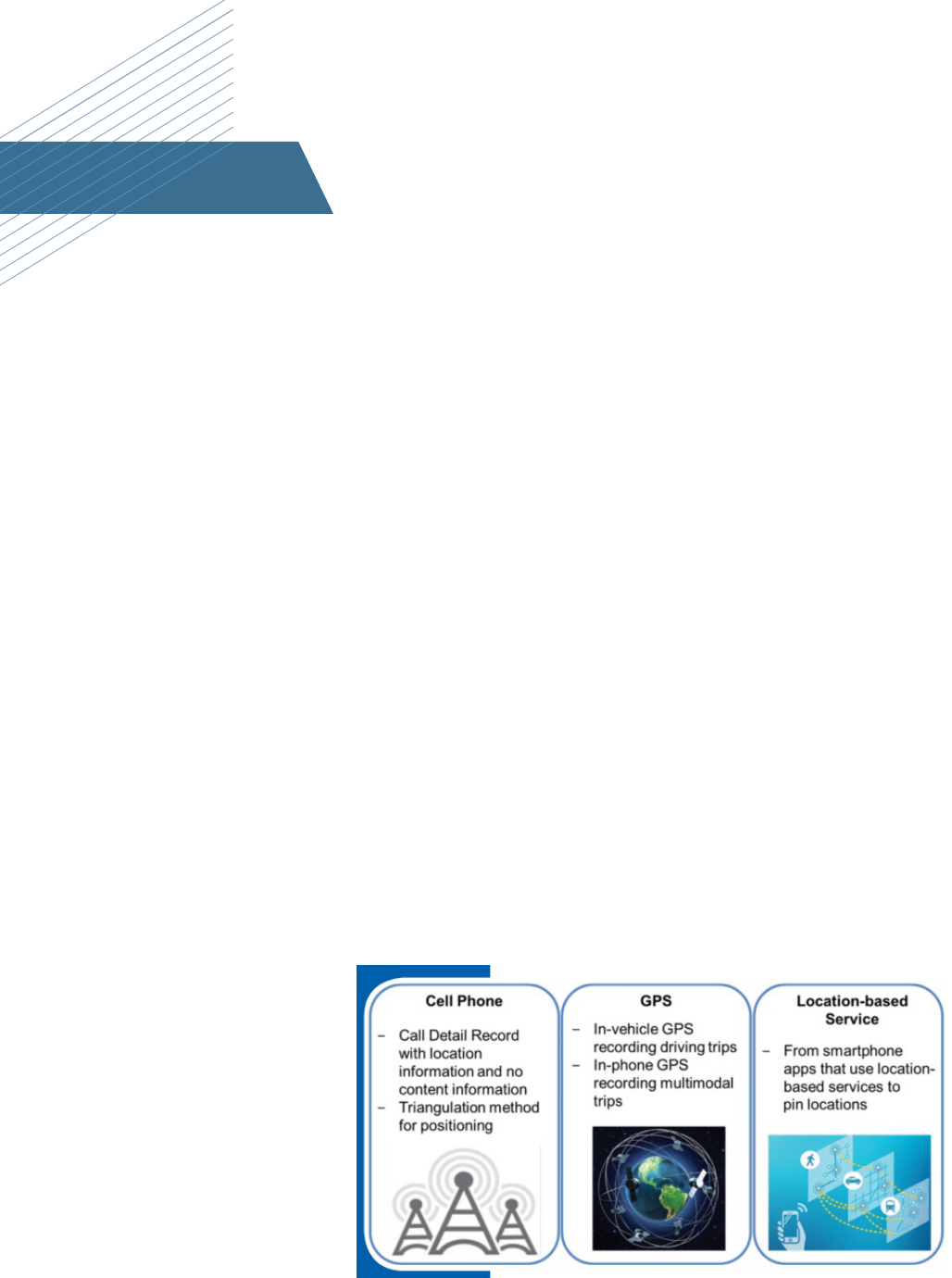
Section
FEDERAL TRANSIT ADMINISTRATION 3
Introduction
Purpose and Scope
Over the past decade, location-based service (LBS) data has been used for
a variety of academic, commercial, and public-sector purposes. During the
COVID-19 pandemic, location data has helped government and health oicials
understand people’s movements and risk exposure. Around the same time,
given that traditional data could not quickly or accurately capture the disruptive
impacts on ridership, many transit agencies started exploring LBS data as a
novel tool to better understand travel demand going forward.
This report provides a primer on LBS data and its uses in public transportation. It
defines LBS data, describes the techniques for collecting and processing the data
and the key parties involved. The report highlights opportunities, limitations,
and potential risks of using LBS data, based on the literature and interviews with
data privacy experts. Finally, this report provides recommendations to transit
agencies on the prudent, safe, and eective use of LBS data.
What is Mobile Device Location Data?
Mobile devices can collect data in a variety of ways. In some cases, the user
directly consents to the collection by responding to a prompt; alternatively, the
user may indirectly consent to the collection by simply using a particular app.
LBS data, similarly to cell phone and GPS data, are generated through passive
data collection. The accuracy of data varies by location data sources. The spatial
precision of in-vehicle navigation-GPS is three to five meters. LBS has five to
25 meters spatial precision, while that for cellular towers (cell phone data) is
100-2000 meters [1]. Passive data collection relies on continuous data collection
from the signals that mobile devices use. These signals are shown in Figure 1-1.
Figure 1-1 Passively Collected Mobile Device Data Sources [2]

FEDERAL TRANSIT ADMINISTRATION 4
SECTION
|
1
Location-Based Service Data
LBS data – the focus of this report – comes from a method where smartphone
providers determine the phone location using GPS, Wi-Fi, and cell phone
towers. These location data are packaged by smartphone providers for apps
– generally called Location Services on Apple and Google devices [3]. More
recently, smartphones have increasingly included more visibility for users to
know how this information is shared with dierent apps.
Raw LBS data consist of geographic coordinate locations across time for
dierent devices. Typically, these raw data are transformed into trip-level
data of origins and destinations based on when a mobile device begins to
dwell in a particular location. Private companies analyze these data to provide
information about the device user (e.g., home locations, work locations,
demographics of home location), and are increasingly able to assign the
transportation mode across trips. This is particularly relevant for transit
because it allows a better understanding of how transit relates to a person’s full
trip from origin to destination, and a person’s larger travel patterns.
Cell Phone Data
Traveler location data can be provided by cell phone carriers using triangulation
from cell towers. This provides a more generalized location than other
data types. Travel mode is diicult to infer using this data as device speed
measurements cannot be measured with detail. Cell phone carriers can supply
this data directly, but oen in a less processed format than what is available
from a third-party data vendor.
GPS Data
GPS data can be supplied from either vehicle navigation systems or mobile
devices. In general, mobile devices have their GPS data recorded by mobile
operating system developers, such as Apple and Android.
Other data sources
There are other emerging data sources that can provide location information
of travelers or vehicles which are not considered in this study. Some of these
data sources only collect data from specific modes (e.g., connected vehicles
or micromobility). Other sources include: 1) using dierent communication
technologies (e.g., Bluetooth and Wi-Fi), or 2) relying on users actively sharing
location and traic data through apps owned either by a transit agency or a
third-party company. A few examples include:
• Vehicle probe or connected vehicle data: Vehicles are increasingly able
to collect data while being driven. This can include origin-destination (O-D)
data and information on vehicle events while driving. Where vehicle trips

FEDERAL TRANSIT ADMINISTRATION 5
SECTION
|
1
are dominant in a region, vehicle data may be a substitute for LBS data, but
vehicle trips will not be able to provide information on trips taken on public
transit.
• Bluetooth and Wi-Fi data: Bluetooth Wi-Fi signals emitted by passing
devices can be collected via beacons. Devices generally change their media
access control addresses constantly, so the Bluetooth or Wi-Fi data are
not commonly used for trip-level or device-level analyses now that other
options are available.
• Fare collection apps: Some transit agencies have apps where transit
riders may pay their fares and learn more about the transit system. These
apps may be able to generate their own data from users. However, it is
not clear that any fare collection apps have demonstrated the ability to
collect suicient travel data to be useful in transit planning. This may be an
opportunity for future innovation for transit agencies.
• Active mobile device data collection: Not all smartphone apps passively
collect location information. Some apps, such as Strava and Waze, rely on
users that actively consent to their data being collected.
How Are LBS Data Collected?
Collecting LBS data requires an application that uses location-based service,
a position mechanism to collect geodata, a mobile network to transmit and
receive data, and soware running on a remote server to compute and deliver
relevant data to users based on geographic location. In a broad sense, the LBS
data ecosystem is composed of four parties: data generators, data collectors,
data vendors, and data users (See Figure 1-2). Data generators refer to cell
phone users whose data are passively collected by the LBS data collectors.
Data collectors (“middlemen”) combine, process, and sell the raw data to data
vendors, who then validate, analyze, and extract information on travel patterns.
Many vendors fit more than one of these supplier type categories. Data users
refer to entities, such as transit agencies, that rely on the insights generated
from the LBS data to make business decisions. Users may never touch the
disaggregated LBS data or know exactly which apps or technologies the data
are collected through.
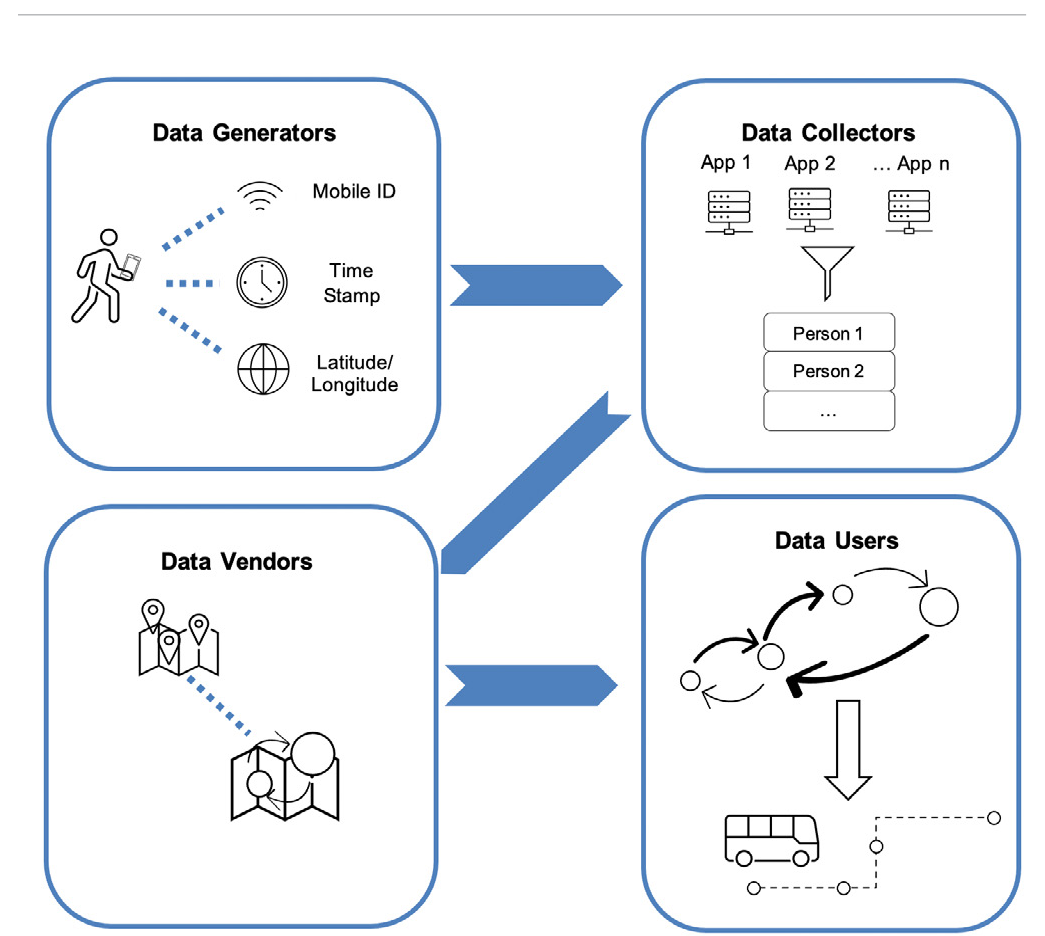
FEDERAL TRANSIT ADMINISTRATION 6
SECTION
|
1
Figure 1-2 LBS Data Ecosystem
How Are LBS Data Processed?
LBS data can be processed in various ways, depending on the data vendor
and its business model. In its most raw form, the data captures individual
coordinates from cell phone and GPS data. Another level of processing
combines these raw data with other information, such as survey data or data
from mobile applications. At the aggregated level, the data might be grouped
in an interactive dashboard that transit agencies can access to identify trends
such as O-D flows. LBS data is oen combined with other contextual data, such
as census data, ridership data, and road and transit network data, to provide
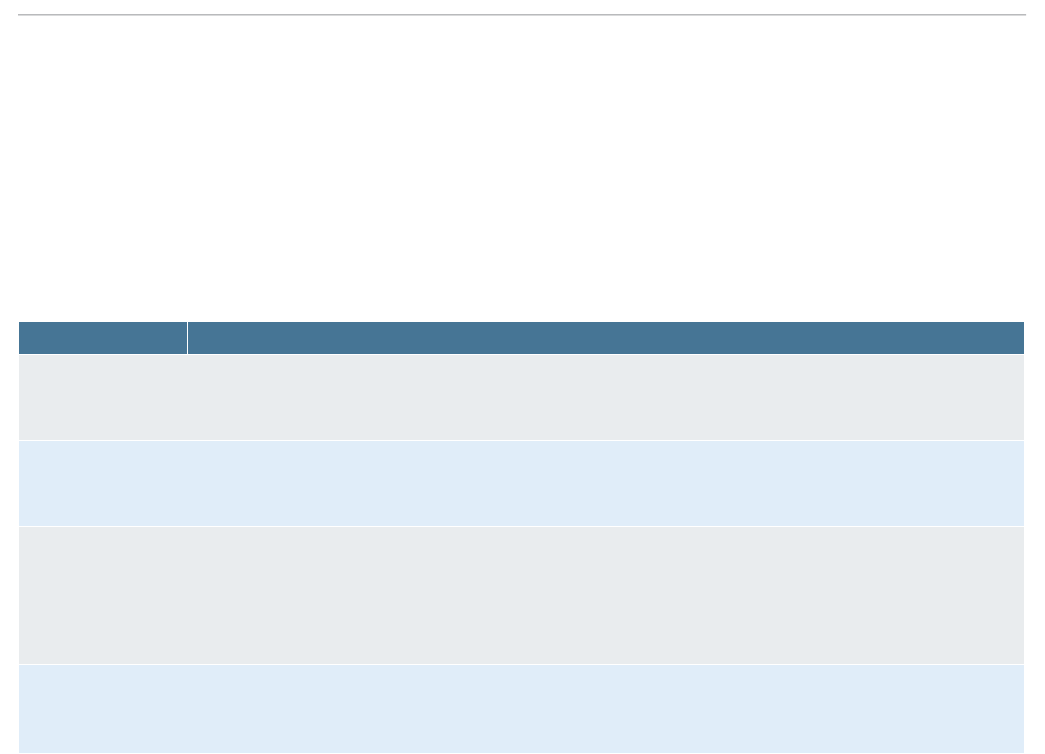
FEDERAL TRANSIT ADMINISTRATION 7
SECTION
|
1
useful insights to meet a transit agency’s needs. For instance, census data can
be combined with LBS data to analyze demographic characteristics of travelers,
and ridership data can help validate the modes assigned for dierent trips in the
LBS data.
Table 1-1 lists several key data measures derived or implied from LBS data, and
which rules are typically followed to derive those measures.
Table 1-1 Major Data Measures from LBS Data
Data Measure How Typically Calculated [4] [5]
Trips
When a mobile device remains in the same place for longer than a certain amount of time – for
example, 5-20 minutes – then a provider can generally assume that a trip has ended and the user is
now dwelling in a certain location. A new trip can be started when the user begins moving again.
Home and Work
Location
With longer periods of data, providers may be able to find patterns in where device owners spend
their nighttime and daytime hours. In general, providers can assign usual nighttime locations as
home locations and usual daytime locations as work locations.
Demographics
At a high level, providers can use two general approaches for demographics. Both begin by using
the census tract information for the device owner’s predicted home location.
1) Based on this census tract demographic information and other travel patterns, providers can
predict the device owner’s demographic information.
2) Provide the percentages of demographic information in a mobile device’s “home” census tract.
Mode Type
Providers can overlay the device’s speed and location onto a mapping service, such as
OpenStreetMap, to predict the mode type for any part of a trip. This can be aided using ridership
data from a transit agency. Mode options include bus, rail, bicycle, and pedestrian.
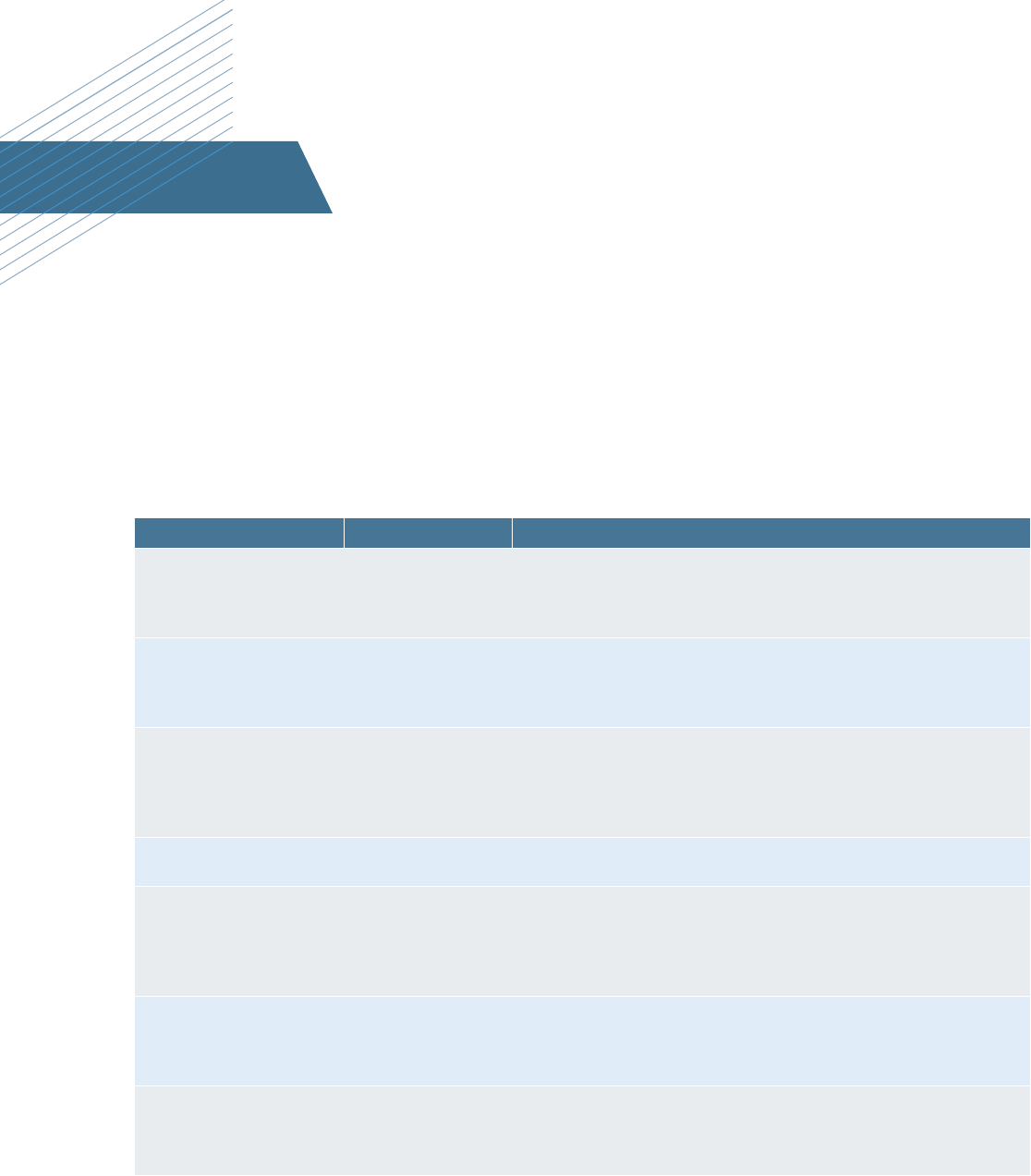
Section
FEDERAL TRANSIT ADMINISTRATION 8
Methodology
Literature Review
The project team reviewed literature on LBS data in transportation published
by transportation planning agencies, the private sector, and nonprofits. The
literature review included information on multiple types of mobile device data
and other sources of “big data” that could potentially complement or replace
LBS data. The project team reviewed dierent products from transportation
planning agencies, shown in Table 2-1. LBS data use cases are relatively more
established for personal vehicles, so this review included multi-modal uses.
Table 2-1 Major Transportation Planning Documents Reviewed
Title Agency Overview
Big Data for Regional
Travel and Mobility
Analyses [6]
Metropolitan
Washington Council
of Governments
(MWCOG)
MWCOG completed a study on the dierent big data available,
along with possible use cases and limitations of these data. The
evaluation included more than 20 big data products and how
they addressed the MPO’s programmatic needs.
Big Data Pilot Project
for Transportation
Planning: Replica [7]
Sacramento
Area Council of
Governments
(SACOG)
This series of documents covers SACOG’s methodology to create
the regional travel patterns based on LBS data from Replica.
Transit Bus Routing On-
Demand: Developing an
Energy-Saving System
[8]
Blacksburg Transit;
Virginia Tech
University
This report provides an analysis on reducing greenhouse gas
emissions from transit buses by using dynamic bus scheduling
and size selection. The project included creating a mobile
application that could generate data from users on rider locations
and destinations.
StreetLight Data Usage
at MnDOT [9]
Minnesota DOT
This presentation covers the major findings and use cases for
Minnesota DOT using StreetLight Data.
Comprehensive
Operations Analysis:
Existing Conditions
Technical Memorandum
[10]
Duluth Transit
Authority
Duluth Transit Authority conducted an analysis of bus operations.
The analysis used AirSage data to look at regional travel patterns,
including origin-destination of trips.
LA’s Plan to Reboot Its
Bus System-Using Cell
Phone Data [11]
Los Angeles Metro
Rail (LA Metro)
As part of the agency’s eort to boost ridership, LA Metro used
location data from 5 million cell phones to understand where
the service gaps are and how to restructure the work to attract
people who could ride a bus.
How We Used Data to
Design an Equitable Bus
Network [12]
Massachusetts Bay
Transportation
Authority (MBTA)
The Bus Network Redesign team at MBTA used LBS data, together
with other data sources (e.g., census data, rider surveys, land
use, and roadway data), to understand travel patterns and rider
needs.

FEDERAL TRANSIT ADMINISTRATION 9
SECTION
|
2
Stakeholder Interviews
The project team used the results of the literature review to conduct
stakeholder interviews. Stakeholders included transit agencies, data vendors,
and data privacy experts, as shown in Table 2-2. The project team provided the
transit agencies and LBS data providers with a set of standard questions (See
Appendix B).
The project team identified transit agencies that had some previous experience
using LBS data for transit planning or operations. As of 2022, only a small
number of transit agencies have extensive experience integrating LBS data
into their planning and performance practices. These transit agencies tend to
serve larger metropolitan areas. The project team also aimed to include smaller
transit agencies that had a dierent perspective on resource constraints and
serving smaller populations or geographic areas.
The project team also interviewed other expert stakeholders to provide
additional context on LBS data. These included the major data vendors being
used by transit agencies today to understand some of the nuances in the LBS
data and analytical tools oered by each company. Expert stakeholders in
nonprofit and academia also oered a broader perspective of the potential
future risks of LBS data that transit agencies may face.
Table 2-2 Agencies Interviewed and Ailiated Role
Category Agency
Transit Agency
New Jersey Transit (Newark, NJ)
Alameda County Transit (Oakland, CA)
Massachusetts Bay Transportation Authority (Boston, MA)
Washington Metropolitan Area Transit Authority (Washington, D.C.)
Los Angeles Metro Rail (Los Angeles, CA)
Duluth Transit (Duluth, MN)
Minneapolis Metro Transit (Minneapolis/St. Paul, MN)
King County Metro (Seattle, WA)
Data Vendor
StreetLight Data
Replica
Cambridge Systematics (Locus)
Data Privacy Expert
Electronic Privacy Information Center (EPIC)
American Civil Liberties Union (ACLU)
Georgetown Law School, Center on Privacy and Technology
University of Washington, Department of Urban Design and Planning

Section
FEDERAL TRANSIT ADMINISTRATION 10
Key Findings
Data Vendors and Products
This section describes approaches to gathering, analyzing, and sharing LBS data
used by Cambridge Systematics, Replica, and Streetlight, the companies who
are the most common data suppliers to transit agencies in 2022. In addition to
the three vendors described in this section, there are other companies in the
field whose work/products are not discussed in this report.
Cambridge Systematics works with Place IQ, a location intelligence service
provider, to acquire anonymized LBS data. The company validates the data
against national-level travel behavior data [13]. It also oers consulting services,
including data acquisitions, processing, building interface, and providing
visualization. The company combines data collected through dierent sources
including data from transit agencies, such as APC and transit card data. Transit
agencies can understand trips by time of day, day of week, travel mode, trip
purposes, and traveler types via the dashboards developed by the company.
Replica is an online platform that provides granular information on travel
patterns, including network-link volumes, O-D pairs, and specific characteristics
of travelers, all of which is calibrated against “ground-truth” data to ensure
quality. The platform could help users understand travel patterns and
demographics of specific cohorts (such as transit riders, low-income residents,
or commuters), identify the characteristics of travelers who utilize certain
network segments, and monitor travel changes in near-real-time. Replica
oers data at multiple time horizons, ranging from weekly and seasonally to
long-term. Replica synthesizes a composite of data inputs, including LBS data,
connected-vehicle data from both personal vehicles and commercial freight
vehicles, points of interest (POI) and associated visits data, publicly available
and proprietary real estate data, payments data, and traic and transit
ridership counts. The company relies on the composite approach to reduce
sampling bias.
StreetLight Data provides online products to measure travel patterns of
vehicles, bicycles, transit riders, and pedestrians. StreetLight’s metrics are
primarily derived from the following data sources: LBS data, connected-vehicle
data, GPS data, data from vehicular, bicycle and pedestrian sensors, land use
data, parcel data, census characteristics (e.g., demographics, vehicle ownership,
housing density), road network, and characteristics from OpenStreetMap.
Streetlight allows users to select various types of customized zones for analysis,
such as block groups, or more specific areas like a city block or trail. Some
key industry standard metrics available in the platform are segment analysis,
routing, O-D volumes, speed, traic volumes, annual average daily traic, and
turning movement counts [5].

FEDERAL TRANSIT ADMINISTRATION 11
SECTION
|
3
Although the data vendors rely on similar sources of data, the ways that those
vendors process, analyze, and summarize the data vary in the following ways:
Data processing and analysis: Dierent data vendors combine LBS data with
dierent additional datasets and follow dierent analytical approaches to
process the data. Transit agencies can decide on customized geographic areas,
such as neighborhoods, transit hubs, or major corridors, and times to require
more specific data for their analysis. Data vendors are working with transit
agencies to continually improve their analytical process and outputs. If using
customized geographies, transit agencies might work out an agreement with
the data vendor for identifying the geographic scale for aggregating LBS data
and identifying several geographic zones for analysis. Additional variations
include:
• Time lag: some data vendors update their LBS data more frequently and
with shorter time delay compared with other vendors.
• Levels of customization: some vendors present their customized
dashboards and some of them work with transit agencies to add features
to suit their needs.
• Additional support: some vendors oer consulting services in addition
to an LBS data platform or oer access to less processed data outside of
the platform that agencies can either process on their own or work with a
contractor to process.
Transit LBS Use Cases
Transit agencies have only recently begun to use LBS data for planning and
operations. Of the transit agencies interviewed for this study, the first transit
agency began using LBS data in 2018. By comparison, in 2013, one year aer
StreetLight data became available, FHWA began its National Performance
Management Research Data Set (NPMRDS), which relies on vehicle probe data to
measure the performance of the National Highway System [14].
Several transit agencies interviewed mentioned that they first began to use LBS
data to develop a better understanding of travel patterns throughout a service
area by all transportation modes, in order to identify transit’s market size and
share (including region-wide and in specific corridors). Transit agencies also
hope to use LBS data to identify trip lengths, demographics of travelers, and
trips taken outside of a transit network. This information can help agencies
make informed planning and operations decisions.
In addition to using LBS data for exploratory analysis, agencies identified
specific use cases summarized in Table 3-1.
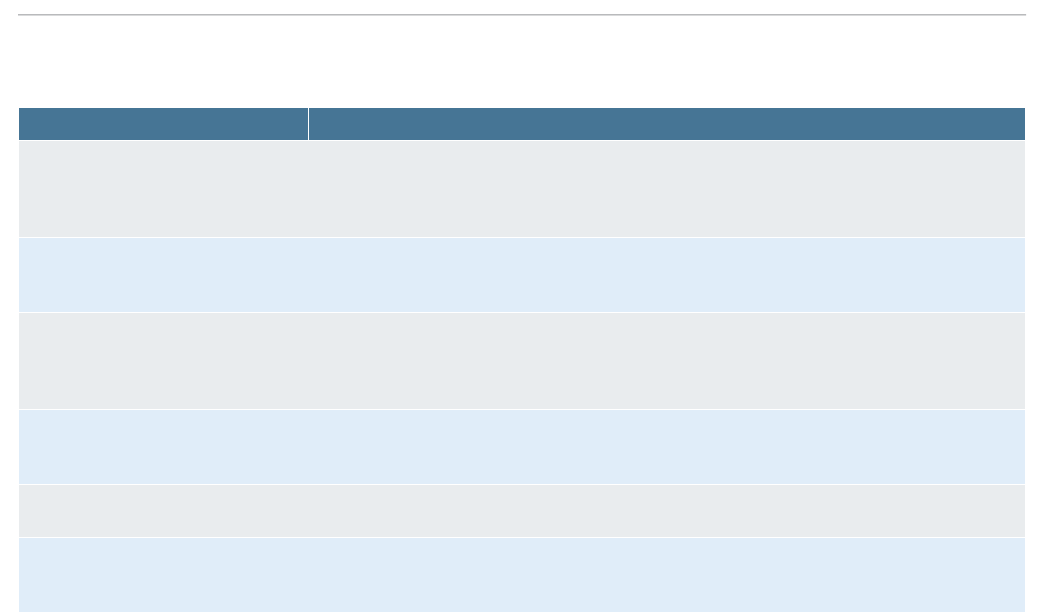
FEDERAL TRANSIT ADMINISTRATION 12
SECTION
|
3
Table 3-1 Major Existing/Proposed LBS Data Use Cases by Interviewed Transit Agencies
Transit Use Case Description
Redesigning Bus Network
Analyze origin-destination for transit and non-transit users to understand regional
travel patterns, the impacts of disruption on the transportation network (e.g.,
COVID), emerging markets for new transit trips, and the potential to adjust bus
routes to better meet trip demands.
Improving Bus Operations
Identify on-time performance along certain bus routes or corridors throughout a
metro area. For current routes, this may be used to justify bus rapid transit (BRT) on
certain corridors. Another case is to guide transit signal priority decisions.
Improving Integration between
Transit and Other Modes (e.g.,
first-/last-service provision)
Understand market share of transit relative to other modes, such as driving and
Transportation Network Companies (TNCs) and use trip-level information to show
how transit networks relate to a person’s entire trip, including the first/last mile or
trips with multiple stops.
Prioritizing Investments
Better target investments, improve transit services at underserved communities, or
plan for last-mile trips. This would likely be used with the demographic information
generated by the data vendors.
Emergency Response
Understand incident response times and dynamics, which could be useful for power
outages, hurricanes, or other disasters.
Public Engagement/Marketing
Identify opportunities for public engagement (e.g., identifying places with large gaps
between predicted ridership and actual ridership, and then targeting these areas for
transit outreach and marketing).
Bus network redesigns are one of the primary use cases and the following
transit agencies that were interviewed have conducted or are exploring the use
of LBS data for service restructuring:
• Los Angeles County Metropolitan Transportation Authority (LA Metro) is
one of the early adopters in this area. The agency used LBS data from 5
million cell phones in LA County to understand traveler behavior. By using
the LBS data, together with fare card data, the agency identified service
gaps and supported bus route redesigns.
• The Massachusetts Department of Transportation (MassDOT) and
Massachusetts Bay Transportation Authority (MBTA) used a variety of data,
including LBS data and metrics, to understand where people travelled on
all modes and to design an equitable bus network.
• Washington Metropolitan Area Transit Authority (WMATA) used LBS data
to better understand non-transit travel following LA Metro’s experience of
using LBS data for bus network redesign.
• New Jersey Transit used LBS data to identify places/routes where more
resources were needed and where redesign was required.
• Minneapolis Metro used O-D patterns from LBS data to review bus service
to an area with residential and commercial properties.

FEDERAL TRANSIT ADMINISTRATION 13
SECTION
|
3
Transit Agency Observations
1. Transit agencies have selected data vendors based on dierent
criteria including data ownership, transparency, specific data
elements available (e.g., mode share, demographic characteristics,
trip length), latency, and granularity.
a. Several transit agencies wanted to procure data so that the agency
can own the data and apply it to future work or share the data
internally or with peer agencies.
b. The capability to modify vendor data output and the approach taken
by vendors are both reasons for choosing a specific data vendor
versus another.
c. Some transit agencies mentioned that they were looking for specific
measures from the LBS data products, such as mode share (including
bike and pedestrian), demographic information associated with LBS
data, and trip length (especially short trips). Additional factors the
agency considered include how LBS data is processed and analyzed,
and whether it can be easily explained to the public.
d. How soon the data can be turned around and if the data are
suiciently granular to provide insights that transit agencies need are
additional key factors for selecting a data vendor.
2. Transit agencies oen access LBS data products through a
subscription. Some agencies purchase LBS data directly from a vendor,
while others go through a contractor that helps to process the data.
Some agencies partnered with neighboring agencies/MPOs/state DOTs
to secure licenses for surrounding areas. Subscriptions to LBS data and
services are oen for a one-year commitment.
Several transit agencies indicated that their MPO or state DOT also
purchased LBS data (some with the same data vendor and others with
a dierent vendor). Transit agencies may need to consider whether
they could share the subscription with other agencies or would need to
purchase their own subscription.
3. Transit agencies have worked closely with vendors. Transit agencies
reported they have worked with data vendors for help on how to use
LBS data and to ask questions about vendor methodologies. One transit
agency was able to use their own data to correct how the data vendor
defines specific concepts of race/ethnicity. Data vendors interviewed
have updated their products using transit agency feedback.
4. Processing LBS data can be time- and labor-intensive: Transit
agencies mentioned they still require sta with technical expertise to
work on LBS data even with assistance from a data vendor. Several

FEDERAL TRANSIT ADMINISTRATION 14
SECTION
|
3
transit agencies indicate that it took much longer than they planned to
process the data. Meanwhile, some agencies recognized that it requires
a bigger team to work on LBS data.
5. Transit agencies believe LBS data is a useful decision support tool.
One transit agency reported that they were able to understand travel
demand from LBS data, which helped guide their bus route redesign.
The agency was able to compare the transit service with other travel
modes and identified key turning points where transit became a less
attractive mode. Another transit agency mentioned its market vendor
was using LBS data and GTFS feeds to measure how many people in the
area could see bus ads/billboards.
6. Aggregated data can meet the needs of transit agencies. LBS data is
usually presented in a dashboard that may display zonal-level counts.
Agencies are also generally able to access deidentified data outside
of these dashboards; however, this requires additional processing
to make the data usable. Even though some transit agencies could
have access to disaggregated and anonymized LBS data through their
subscription service, interviewees reported they are not interested in
acquiring disaggregated data due to state data privacy law, privacy
concerns in general, and technical challenges associated with making
sense of the data. Agencies indicated that aggregated information can
oen suiciently answer their questions so there is no need to acquire
disaggregated data.
7. Customization may be needed. All the data vendors interviewed
provide user access via dashboards that visualize measures like O-D
patterns and allow users to download the data behind the dashboard.
Data vendors typically allow the data to be downloaded in CSV format
and viewed with visualization tools, such as PowerBI.
One data vendor mentioned that over 90 percent of projects can
be completed using the information on its platform without any
customized support from the company. However, some transit agencies
would like the data presented at additional levels of granularity and in
this case would need additional support. Agencies additionally noted
the need to process some data outside of what was displayed in the
vendor platforms, which can lead to incurring costs beyond the basic
subscription.
8. Transit agencies need LBS data to include transportation modes,
demographic characteristics of travelers, and time of day.
Identifying mode was important to several agencies. One transit
agency originally purchased O-D flow data but found it did not provide
suicient information.

FEDERAL TRANSIT ADMINISTRATION 15
SECTION
|
3
9. The changing nature of the data has been an issue for some
agencies. External impacts, like term changes from mobile operating
systems, can lead to changes in how apps collect personal information
of users, which further influence vendor data outputs. One agency
mentioned that data structure changes on the vendor side could
cause the delay on utilizing LBS data. At the same time, data collection
methodology changes are usually an improvement, but need be
explained to other stakeholders.
10. There can be significant time investment to integrate LBS data
into existing systems. Several transit agencies identified having the
LBS data output to fit into the agencies’ existing workflow could be a
challenge. For instance, a transit agency may expect the LBS data being
generated at specific geographic scale to fit into their existing system.
11. Transit agencies expressed the following concerns about LBS data
validity and coverage:
a. Demographic characteristics of travelers can be challenging to
infer. Data vendors typically relate mobile device data to census
data and identify a traveler’s demographic information based
on the inferred home location (the location where the cell phone
user spends most of the nighttime). Some transit agencies raised
concerns on how demographic characteristics are assigned to
travelers. For example, if an area has a mix of households in dierent
racial or income categories, it will take additional information to
infer a traveler’s demographic information and could still be hard
to validate. Data vendors also recognized similar challenges when
identifying communities of color or tagging households with income
categories. There is a challenge in validating the inference at a very
granular level while retaining privacy.
b. Time thresholds used for determining when a trip ends may over-
represent short trips. One transit agency reported a discrepancy
between the O-D pattern for transit trips derived from LBS data
compared with the pattern the agency developed using its internal
data. The agency also raised questions about the time threshold
used to determine when a trip ends. For instance, data showing a cell
phone stopping in one place for a few minutes could mean that the
trip is complete, or it might mean that a traveler is waiting for a bus
or rail transfer.
12. Agencies reported that LBS data is still useful despite demographic
coverage caveats. Most transit agencies acknowledge that certain
demographic groups are under-represented or even excluded
from the LBS data, such as travelers over 85 or under 16. However,
some agency representatives noted that LBS data still provides a

FEDERAL TRANSIT ADMINISTRATION 16
SECTION
|
3
more comprehensive view of people’s travel patterns compared to
conventional datasets, so the sample bias is not a significant concern
for them. Some interviewees noted that the benefits of using LBS data
products outweigh the drawbacks.
13. Transit agencies have not experienced pushback from the public
regarding privacy. No transit agencies among the group interviewed
for this report reported any privacy concerns raised to them by
members of the public. All the transit agencies and data vendors
interviewed have been open with their methodologies of using and
analyzing LBS data. To protect the privacy of travelers, some data
vendors emphasize that, not only do they share travel data at the
aggregated level, but they also avoid capturing people’s visits to specific
locations, such as hospitals and rehab facilities.
14. Transit agencies are sharing their experiences and are draing
guidance for future uses. Some transit agencies mentioned that they
were working on developing guidance on how the LBS data can be
used and that they plan to make their information available to other
operators. One transit agency listed a few key questions for other
agencies to consider before procuring LBS data, such as asking for data
samples, conducting spot checks, and understanding data formats.
15. In the future, LBS data products may be influenced by external
factors, such as changes to Apple or Google privacy settings and
other terms and conditions. One data vendor’s service shut down for
a short period of time when Apple’s private policy changed. Some data
vendors indicated they have started adopting strategies to plan ahead
and mitigate the potential impacts of those external changes on their
service.

Section
FEDERAL TRANSIT ADMINISTRATION 17
Feasibility Analysis
This section provides analysis, recommendations, and other information for
transit agencies that are considering using LBS data.
Advantages
Transit agencies identified several key advantages of LBS data compared with
more traditional data. LBS data is good for understanding high-level traic
volumes across various modes. The data has more spatial coverage and better
temporal resolution. Compared with traditional travel survey data, which could
take up to five or 10 years to update, LBS data updates more frequently and can
capture disruptive changes in a timely fashion. LBS data is also available for
historical time periods, generally starting around 2017.
Relationship between LBS and Traditional
Transit Data
Some interviewees are optimistic that LBS data will eventually be able
to accurately identify trips made on dierent transportation modes and
dierent trip segments. However, none of the transit agencies or data vendors
interviewed consider LBS data as a replacement to travel surveys or passenger
counting systems, nor can LBS data provide information on trips not taken.
Travel surveys still provide key information for a number of other operations
and planning processes.
Technical Challenges
Despite rapid advances in the field of LBS, many challenges still exist,
including analysis of LBS, applications, evaluation, and privacy concerns [15].
The literature review and interviews highlighted the following key technical
challenges:
1. Transit agency interviewees and other stakeholders described LBS data
as a “black box,” where complex algorithms are used to combine many
data sources in dierent formats to calculate key statistical summaries
on trips and mode share.
2. Even though data vendors have been open and transparent about
the methods they use to identify individual trips and travel modes
associated with each trip, the information is still inferred from the data,
based on assumptions. Those assumptions could have caveats under
specific circumstances. For example, trips are generally determined by
the movement of the cell phone user. If the user remains in the same
place for longer than a certain amount of time, it will be treated as

FEDERAL TRANSIT ADMINISTRATION 18
SECTION
|
4
the end of a trip. Transit agencies found this could be problematic for
determining transit trips because transit users could be transferring
between vehicles.
3. Specific modes of interests to transit agencies, like walking and biking,
do not have suicient representation in the LBS data.
4. LBS data modelers combine the cell phone-based data with other
information (such as land uses, POI, census data, APC, and road and
transit networks) to understand travel patterns and make sense of what
the LBS shows in comparison to what transit agencies already know.
Data from dierent sources oen are collected at dierent points in time
and could lag behind the LBS data. In addition, delays between when
the datasets are prepared and when they are purchased can lead to out-
of-date information. One transit agency used 2019 data in 2022, which
le post-pandemic travel patterns out of the picture.
5. Transit agencies found that it is hard to determine which geographic
areas to designate for analysis. One transit agency noticed that
conventionally used geographic areas (e.g., census tracts or traic
analysis zones) dier from the actual transit layout in its region. The
agency provided the example of a bus stop that may serve the people
in a specific census tract, but the geographic location of the stop falls
outside of the census tract.
6. Evolving data sources and algorithms for analyzing LBS data make it
diicult to make year-over-year comparisons of the data.
Organizational Challenges
1. Transit agencies face challenges when choosing between data
providers. Transit agencies found it hard to compare the benefits and
costs of contracting with a specific data vendor because each vendor
has a dierent set of products and data processing procedures.
2. Transit agencies need sta with technical expertise to work
directly with LBS data. Although some agencies reported procuring
consulting services to use LBS data, interviewees mentioned that
sta with data science backgrounds or training for sta with more
traditional experience was necessary to use LBS data eectively. Transit
agencies whose sta have greater technical expertise could conduct
more exploratory work, whereas agencies with more limited technical
experience and resources would need to choose use cases with a limited
scope and more established history.
3. The cost-benefit tradeos of using LBS data are not well defined.
Although all transit agency representatives interviewed in this study

FEDERAL TRANSIT ADMINISTRATION 19
SECTION
|
4
reported that they found LBS to be a useful tool, no interviewee put a
dollar value or otherwise quantified the insights that the data provided.
The cost of using the data also varies, and includes sta time spent using
the data as well as the cost of a subscription. Smaller agencies who
find the cost of purchasing LBS data (which can run into the hundreds
of thousands) to be prohibitive may find a more aordable option in
partnering with a state DOT or MPO that has access to the data.
Bias, Misuse, and Privacy Concerns
Data from smart phones and other location-aware devices make it possible
to track the precise movements of millions of people. At the same time, not
all people use cell phones, either because of age, aordability, or personal
preferences. Critics of LBS data have expressed two major concerns about the
practice: 1) the data may not be a representative sample of the population being
analyzed, and policy decisions based on LBS data may be biased against people
without cell phones; and 2) using LBS data supports an industry that poses
serious threats to privacy and civil liberties, even if the end user does not have
access to personal information. Privacy risks may vary depending upon which
LBS data have been acquired, how the data are used, and what constraints (e.g.,
regulations/laws on data privacy) are in place that transit agencies must take
into consideration.
Data Bias
LBS data captures travel behavior of cell phone users. Several prerequisites
include owning a smart phone, paying for cell phone/internet service that
provide full time service, and a good connection to a cell phone tower or
Wi-Fi network. This means specific demographic groups, such as school-aged
children or elderly, low-income, and rural residents, could be underrepresented
or ignored. The vendors interviewed in this study described methods to adjust
their results to account for under-represented populations. Transit agency
representatives interviewed did not raise demographic coverage as a major
concern. However, transit agencies using LBS data should be aware of the
perception of data bias.
Data Privacy and Misuse
LBS datasets may contain sensitive information and are at risk for misuse
and abuse by individuals that have access to the data. Data privacy experts
emphasized that, while raw data pose a direct and significant privacy risk,
data that have been processed may pose the same or greater privacy risk.
Companies processing LBS data to determine home and/or work location data,
and then appending additional data to the records such as demographics,
are re-identifying the individual and increasing privacy risk. Although transit
agencies may not have purchased disaggregated data, privacy experts

FEDERAL TRANSIT ADMINISTRATION 20
SECTION
|
4
cautioned that supporting the LBS industry over time could increase the odds
that abuse would occur “upstream.” Several data privacy experts interviewed
highlighted the potential risk that malicious actors may use LBS data for
harassment or stalking.
Data privacy experts also cautioned that aggregation itself can be challenging.
For example, areas with dierent population densities or neighborhoods with
specific demographic groups may require dierent levels of aggregation.
Households living in low-density areas require a higher level of aggregation
because there might be only a few households at a disaggregated geospatial
scale. Households from lower-income neighborhoods may also need a higher
level of aggregation. Their travel patterns are more uniquely identifiable
because they face more constraints on traveling; for instance, they may be
more likely to travel long distances, work late hours, and travel to particular
destinations for work or socializing.
In order to avoid misuse of the data to identify a specific household, larger
samples will be required to share similar travel attributes in order to protect
the activity patterns of low-income travelers. Privacy advocates noted that
re-identification of individuals in previously aggregated data is possible and
that even aggregated data can contain information to sensitive destinations
such as hospitals, drug rehabilitation centers, and abortion clinics. Data privacy
researchers pointed out that there is currently no assured way to anonymize
LBS data, because the geo-spatial traces of people over time provide enough
information to personally re-identify more than 95 percent of the population,
even when aggregated per hour and at the spatial level of cell tower [16]. With
this level of re-identification possible just from geo-spatial locations over time,
the privacy risk is high and prevalent, even if so-called 'personally identifiable
information' such as name or birthdate have been removed.
Public Perceptions and a Changing Legal Landscape
The Public is Concerned about Data and Privacy
The public is generally concerned with their online and oline activities being
tracked and monitored by companies and the government. A study conducted
by the Pew Research Center found that most Americans feel “their personal
data is less secure now, that data collection poses more risks than benefits, and
believe it is not possible to go through daily life without being tracked” [17]. The
major concerns that Americans have regarding personal data being collected
include:
• Lack of control over which data are being collected,
• Lack of understanding of who can access their online and oline data and
how data are being used, and
• Risks outweigh the benefits to an individual.
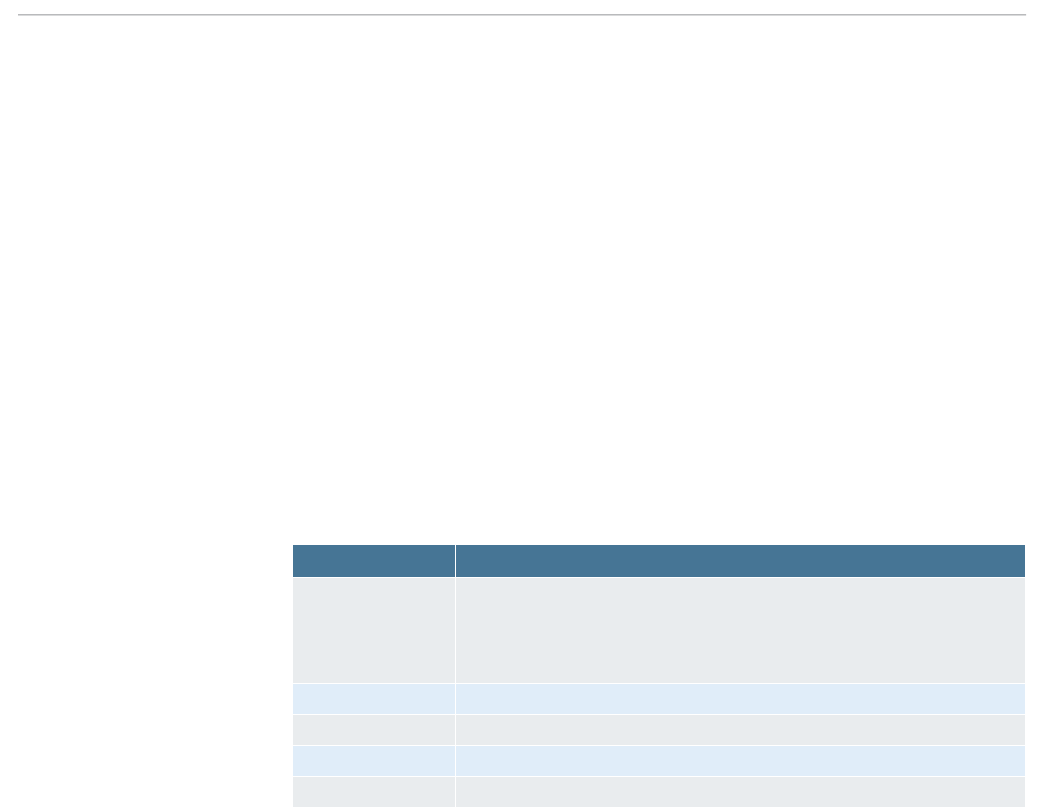
FEDERAL TRANSIT ADMINISTRATION 21
SECTION
|
4
For LBS data, an earlier Pew study shows that as of April 2012, over 35 percent
of adult cell phone app users said they have turned o the location-tracking
feature on their cell phone due to privacy concerns [18]. These users were
worried about other people or companies being able to access their location
information. Public perception toward privacy is inherently dynamic because it
can change over time at the individual and societal levels. As people’s lives are
increasingly disrupted by personal information leaks, how privacy is defined
and evaluated may continue to change [19].
State- and Federal-Level Data Privacy and Consumer
Protection Laws
Studies tracking the state-level data privacy laws in the U.S. identified that,
as of 2022, five U.S. states had comprehensive data privacy laws in place [20],
including:
Table 4-1 Comprehensive Data Privacy Laws
State State Laws
California Cal. Civ. Code §§ 1798.100 et seq. (California Consumer Privacy Act
of 2018 (CCPA))
California Consumer Privacy Rights Act (CPRA)
Proposition 24, approved Nov. 2020, eective January 1, 2023
Colorado Colo. Rev. Stat. § 6-1-1301 et seq. (2021 S.B. 190)
Connecticut 2022 S.B. 6 (Personal Data Privacy and Online Monitoring)
Utah 2022 S.B. 227 (Utah Consumer Privacy Act)
Virginia 2021 H.B. 2307/2021 S.B. 1392 (Consumer Data Protection Act)
Comprehensive state-level data privacy laws generally give residents the right
to know about what personal information is collected by a company and how it
is used and shared. The laws also generally allow for residents to request their
personal information from companies, request to have their data deleted, and
opt out of having their data sold to third parties.
California has led the establishment of consumer data privacy laws in the
country. The California Consumer Privacy Act of 2018 (CCPA) applies to
information that identifies, relates to, describes, and is (or could be) linked
with a particular consumer. De-identified data, publicly available data, and
aggregated data are exempt from CCPA. The law applies to businesses that
meet specific thresholds, such as processing data of 50,000 or more consumers,
and at least 50 percent of revenue coming from selling data. Under CCPA,
penalties for violators could be up to $7,500 per intentional violation or $2,500
per unintentional violation. Following the CCPA, the California Privacy Right Acts
(CPRA) has gone into eect on January 1, 2023. The CPRA include new rights,
such as giving consumers the right to correct inaccurate personal information

FEDERAL TRANSIT ADMINISTRATION 22
SECTION
|
4
that a company collected about them, and limiting the use and disclosure of
sensitive personal information [21, 22].
Some states have data privacy laws with moderate protective measures in
place, such as Nevada. The law generally mandates that websites must allow
Nevada consumers to opt out of having their personal information sold to third
parties. There are also states with even more limited restrictions for businesses
collecting personal information, including Vermont, Minnesota, Maine,
Delaware, Arizona, Missouri, Oregon, Hawaii, New York, and Tennessee. The
laws in those states may only focus on data collected on specific subgroups of
people, such as children [23].
The General Data Protection Regulation (GDPR) is a data privacy law that
impacts all organizations that sell products and services to people in
the European Union, including American businesses. The GDPR requires
compliance by any entity that processes personal information of consumers,
with no revenue threshold, processing threshold, or broker threshold. The
consequences of non-compliance with the GDPR could be up to $20M or 4
percent of total annual turnover of the preceding financial year worldwide,
whichever is higher [24].
Although there is no data privacy and protection law enacted at the federal
level, H.R. 8152, the American Data Privacy and Protection Act (ADPPA),
represents the latest attempt by Congress to introduce comprehensive federal
legislation regarding data privacy. The proposed ADPPA adopts a “data
minimization” strategy and lists 17 acceptable purposes for data collection and
usage. Moreover, using data for targeted advertising is subject to restrictions,
including:
• Sensitive data (e.g., health information, location, private messages) cannot
be used,
• Companies will be prohibited from tracking consumers using third-party
sites, and
• An opt-out process will be universally implemented.
If passed, it could require uniform compliance for all companies conducting
business in the U.S. On July 22, 2022, the House Energy and Commerce
Committee approved the proposed ADPPA. It is currently under discussion by
members of Congress [25].
Impacts of Term Changes by Apple and Android
to Limit LBS Data and Protect Privacy
Third-party trackers rely on an identifier (also known as an “ad ID”) associated
with each cell phone to collect location data. The identifier was unique,
permanent, and was frequently accessed by third parties without user

FEDERAL TRANSIT ADMINISTRATION 23
SECTION
|
4
knowledge or consent. Following lawsuits and investigations, companies like
Android and Apple started restricting the use of those unique identifiers. In
2021, Apple introduced App Tracking Transparency, which led to a significant
drop in the number of users opting in for tracking. Androids started rolling out a
way for users to turn o their ad ID. However, Android’s ad ID was still in use and
based on an opt-out basis as of April, 2022 [26]. Disabling ad ID makes it harder
for advertisers and data brokers to track an individual cell phone user. Although
removing ad ID will not stop all tracking, this is moving in the right direction to
protect individual privacy.

Section
FEDERAL TRANSIT ADMINISTRATION 24
Recommendations
Transit agencies who are considering using LBS data for the first time or who
are in the early stages of using the data may want to consider the following
approaches:
1. Learn from the “early adopters.” A growing number of transit
agencies, including those listed in this report, may be good sources of
lessons learned and these lessons will proliferate as use expands over
time. Studies such as the ones cited in this report’s literature review and
those published in connection with the Transportation Research Board
(TRB) may also be helpful sources of impartial information.
2. Develop internal technical capacity to evaluate and use the data
eectively. Although data vendors can provide technical assistance to
their clients, using LBS data involves some investment in information
technology resources, sta with data analytics or data science
backgrounds, and/or training for sta who lack these skill sets. Agencies
should consider whether they have the internal resources available and,
if necessary, make plans to invest in their technical capacity and/or work
with consultants.
3. Determine if LBS data is a priority for your agency and weigh the
costs of implementation. Understand the costs and benefits of using
LBS data and determine whether there is/are a specific problem(s) that
LBS data would help your agency solve.
4. Consider partnering with State DOTs, MPOs, and academia. Agencies
that lack extensive technical experience or financial resources to
purchase LBS resources directly may find it helpful to share a license
with a nearby MPO, state DOT, or colleges and universities to explore
transit use cases of LBS data.
5. Consider using LBS data on a limited basis or for a pilot project
before entering a longer-term arrangement. Agencies may want to
request a sample of the data and/or a trial period to better understand
how the data are organized and how they can be used. Using data for a
discrete pilot project, such as understanding travel along a particular
corridor instead of across the entire transit system, may be a useful first
step.
6. Seek to understand data vendor aggregation and analytical
methodologies to the greatest extent possible. Although some
LBS collection and aggregation methods are considered confidential
business information, important details (such as the methodology
used to split trips among modes, how LBS data is validated, how

FEDERAL TRANSIT ADMINISTRATION 25
SECTION
|
5
demographic information is inferred, and how vendors adjust their data
to compensate for underrepresented groups) are publicly available or
can be clarified in conversations with vendors.
7. Develop methods to “ground truth” LBS data, especially if using the
data to evaluate transportation mode splits. Agencies seeking to use
LBS data as a proxy for transit ridership should develop an approach
for comparing the LBS results against internal data, such as information
from APCs. Agencies may also want to share their results with LBS
vendors where discrepancies exist so that vendors can adjust their
models to improve accuracy.
8. Establish strong internal controls for data management and privacy
protection. Steps could include developing a privacy risk assessment
and protocol that evaluates an agency’s existing privacy policies and
strengths, as well as the risks that personally identifiable information
could be misused by agency sta or transmitted outside the agency.
Other risk mitigation measures include documenting which individual(s)
will have access to LBS data and for which projects the data will be used
before an agency begins working with the data, and having a dedicated
privacy oicer who can evaluate the benefits and risks of any data the
agency is using. Protecting LBS data can take place within an agency’s
comprehensive data management framework, which identifies and
classifies the datasets it uses; the data owners or stewards; access
rights; policies for sharing information externally; and procedures for
data storage, archiving, and preservation. Additional recommendations
for transit data privacy protection can be found in the Transportation
Cooperative Research Program (TCRP) report Data Sharing Guidance
for Public Transit Agencies Now and in the Future (2020). In addition, the
TCRP report The Transit Analyst Toolbox: Analysis and Approaches for
Reporting, Communicating, and Examining Transit Data (2021) includes
information and case studies on data management and governance.
In addition, agencies may want to reach out to privacy experts in
the academic community for advice or for assistance with further
anonymizing data. Privacy experts recommended using dierential
privacy tools to inject “noise” into the data as an additional preventive
measure. This approach has been adopted by the U.S. Census Bureau.
However, employing dierential privacy requires trained professionals
spending a significant amount of time and energy to process the data.
Also, there is a tradeo between privacy and accuracy when applying
dierential privacy to data.
9. Be prepared to answer questions about data bias and privacy.
Agency sta may encounter questions from agency leadership, board
members, or members of the public regarding whether LBS data

FEDERAL TRANSIT ADMINISTRATION 26
SECTION
|
5
excludes underrepresented groups or whether the agency has access
to the travel history of individuals. Agencies should be prepared to
describe how the data are being used, as well as the steps they have
taken to protect privacy and guard against data bias.
10. Stay abreast of ongoing technological and legal changes. Agencies
should seek legal counsel regarding any federal, state, or local laws
that govern the use of LBS data. Agencies should also bear in mind
that location-based privacy measures are being debated at the state
and national levels, and that technology companies are responding by
making changes to how they collect location data. Agencies working
with data vendors on an ongoing basis should consult with their vendor
on how new laws or technology company processes may have changed
the data they are receiving and how the data have changed over time.
11. Treat LBS data as one investment in a portfolio of many transit data
products. LBS data and more traditional sources of information are
not mutually exclusive. In fact, since agencies are interested in verifying
LBS data against internal records, they should strive to maintain and
improve their conventional sources of data. Agencies may also want to
consider developing (or taking advantage of) their own fare payment
and travel planning apps that could be used to gather location-based
data from riders who opt into sharing their information. These apps
could be a useful source of information if privacy considerations further
limit LBS data.

Appendix A
FEDERAL TRANSIT ADMINISTRATION 27
Stakeholder Interviews
Interview Guide for Transit Agencies
Context Framing Questions
1. What is your overall impression of the state of LBS data, particularly with
regard to its use in transit?
2. Are you using LBS data?
3. IF SO
Product(s)/Vendors
a. What product(s) are you using?
i. How did you select that vendor(s)?
ii. To what extent did you validate their data against alternatives
and/or existing/traditional data? What QA/QC have you
performed? How have you evaluated the data with respect to
equity/representation?
iii. What was the process for procuring and implementing LBS data
into your workflow? Timeline? Roadblocks?
Utilizing data
b. How are you using them?
i. Do you use the LBS data for service planning, scheduling,
performance monitoring or other purposes?
ii. What role does LBS data play? Does it replace existing data? Or
supplementing existing data?
c. What have been the results?
i. Advantages
1. Quantifiable benefits?
ii. Challenges/Limitations
1. What mitigation strategies have you considered/used?

FEDERAL TRANSIT ADMINISTRATION 28
APPENDIX
|
A
Recommendations/Lessons Learned
d. Recommendations to other agencies
i. What would you advise other agencies to do as part of their
market research? What questions should they ask of vendors?
What expectations should they have in approaching LBS data (in
terms of both capabilities and limitations)?
ii. What internal resources (sta, hardware/soware, data, etc.)
have been important?
Closing Remarks
e. Closeout/Next Steps
i. What resources and/or information would/could be useful from
FTA on this topic?
ii. Who else should we contact for this project (agencies, vendors,
experts)?
If Not Using LBS Data
a. Experience:
i. To what extent have you explored/evaluated its use?
ii. What platforms have you looked into?
b. Purposes of exploring LBS data: What needs/gaps were you looking
to address?
c. Challenges: What has kept you from investing in LBS data?
d. Closing remark:
i. What resources and/or information would/could be useful from
FTA on this topic?
ii. Who else should we contact for this project (agencies, vendors,
experts)?
Interview Guide for LBS Data Providers
Product(s)
1. What types of LBS-related products does your company oer (e.g., LBS
data only, data analysis, etc.)? What capabilities are you oering?

FEDERAL TRANSIT ADMINISTRATION 29
APPENDIX
|
A
2. How mature are those capabilities (i.e., are they available commercially
now or available more for beta testing/development now)? How do
capabilities evolve over time?
3. What is your goal for this product (in the next 5 years)?
Advantages/Use Cases
4. What advantages can transit agencies expect over conventional/existing
data sources?
5. Can you share examples of transit agencies using your data? If so, how
are they using it? What types of output metrics/insights can users
expect to extract?
6. What data sources are reflected in your product(s)? Where does your
company purchase LBS data and what level of process is the data in?
7. How are transit agencies and your company working together to
improve the quality and usefulness of the data provided?
8. What have you learned from your interaction with transit agencies?
What would be helpful from the agencies?
9. To what extent have you run into challenges working with transit
agencies (agency-based technical challenges, terms of use challenges,
skepticism/change management)?
Technical Questions
10. To what extent can agencies validate the accuracy of the data?
11. How do you protect privacy?
12. (How) do you account for representation among travelers who may not
own a smartphone?
Challenges/Concerns
13. What terms/limitations are typically applied to your product(s)?
14. What changes in technology may aect your ability to continue oering
LBS products? (e.g., changes to terms of service)
15. What do partnerships look like with customers?

FEDERAL TRANSIT ADMINISTRATION 30
Acronyms and Abbreviations
AFC Automated Fare Collection
APC Automated Passenger Counter
ADPPA American Data Privacy and Protection Act
CCPA California Consumer Privacy Act
CPRA California Privacy Rights Act
CSV Comma Separated Value
DOT Department of Transportation
FHWA Federal Highway Administration
FTA Federal Transit Administration
GDPR General Data Protection Regulation
GPS Global Positioning System
GTFS General Transit Feed Specification
LBS Location-Based Service
MPO Metropolitan Planning Organization
NPMRDS National Performance Management Research Data Set
O-D Origin-Destination
POI Points of Interest
TCRP Transit Cooperative Research Program
TNC Transportation Network Company
TRB Transportation Research Board
USDOT United States Department of Transportation
FEDERAL TRANSIT ADMINISTRATION 31
References
[1] StreetLight Data, "StreetLight InSight Metrics: Our Methodolody and Data Sources," 10 2018.
[Online]. Available: https://www.streetlightdata.com/wp-content/uploads/StreetLight-Data_
Methodology-and-Data-Sources_181008.pdf.
[2] FHWA Exploratory Advanced Research Program, "The Exploratory Advanced Research Program
Fact Sheet: Mobile Device Data for Origin-Destination Travel Trends".
[3] Electronic Frontier Foundation , "Privacy Breakdown of Mobile Phones," [Online]. Available: https://
ssd.e.org/playlist/privacy-breakdown-mobile-phones#mobile-phones-location-tracking.
[4] Replica, "Replica Methodology for Sacramento Council of Governments," 2020. [Online].
Available: https://www.sacog.org/sites/main/files/file-attachments/replica_methodology_2020.
pdf?1602683559.
[5] StreetLight, "StreetLight Data Sources and Methodology White Paper," December 2022. [Online].
Available: https://learn.streetlightdata.com/methodology-data-sources-white-paper.
[6] Metropolitan Washinton Council of Governments, "Big Data for Regional Travel and Mobility
Analyses," 24 9 2021. [Online]. Available: https://www.mwcog.org/documents/2021/09/24/big-
data-for-regional-travel-and-mobility-analyses-big-data/.
[7] Sacramento Area Council of Governments, "Big Data Pilot Project for Transportation Planning:
Replica," [Online]. Available: https://www.sacog.org/post/big-data-pilot-project-transportation-
planning-replica.
[8] Virginia Tech Transportation Institute, Blacksburg Transit, Kimley-Horn Northern Virginia, "Transit
Bus Routing On-demand: Developing an Energy-Saving System," [Online]. Available: https://ridebt.
org/images/documents/TIGGER_FINAL_REPORT.pdf.
[9] Metro District Planning, "StreetLight Data Usage at MnDOT," in City Engineers Association of
Minnesota 2020 Conference, https://www.ceam.org/vertical/sites/%7BD96B0887-4D81-47D5-AA86-
D2FB8BC0796%7D/uploads/Mining_Cellular_Data_for_Transportation_Studies_Michael_Corbett.
pdf, 2020.
[10] Duluth Transit Authority, "Comprehensive Operations Analysis: Existing Conditions Technical
Memorandum," 1 2021. [Online]. Available: https://ridebt.org/images/documents/TIGGER_FINAL_
REPORT.pdf.
[11] "LA's Plan to Reboot Its Bus System - Using Cell Phone Data," [Online]. Available: https://www.
wired.com/story/future-of-transportation-los-angeles-bus-cell-phone-data/.
[12] "How We Used Data to Design an Equitable Bus Network," [Online]. Available: https://www.wired.
com/story/future-of-transportation-los-angeles-bus-cell-phone-data/.
[13] Cambridge Systematics, "Introducing Locus the Location Based Service Data Solution to
Understand Traveler Behavior and Transportation Demand," [Online]. Available: https://camsys.
com/blog/introducing-locus-the-location-based-services-data-solution-to-understand-traveler-
behavior-and-transportation-demand.
[14] Federal Highway Administration, USDOT, "The National Performance Management Research
Data Set (NPMRDS) and Application for Work Zone Performance Measurement," 9 2020. [Online].
Available: https://ops.fhwa.dot.gov/publications/fhwahop20028/index.htm.

FEDERAL TRANSIT ADMINISTRATION 32
REFERENCE S
[15] H. Huang and G. Gartner, "Current Trends and Challenges in Location-Based Services,"
International Journal of Geo-Information, no. 7, p. 199, 2018.
[16] de Montjoye, Y.A., Hidalgo, C. A., Verleysen, M., and Blondel, V. D., "Unique in the Crowd: the
Privacy Bounds of Human Mobility," Scientific Reports, p. 1376, 2013.
[17] Pew Research Center, "Americans and Privacy: Concerned, Confused and Feeling Lack of Control
Over Their Personal Information," 2019.
[18] Pew Research Center, "Location-Based Services," 12 9 2013. [Online]. Available: https://www.
pewresearch.org/internet/wp-content/uploads/sites/9/media/Files/Reports/2013/PIP_Location-
based-services-2013.pdf.
[19] Ryan Espiritu, "The Future of Location-Based Services and the Implications of User Privacy,"
Viterbi Conversations in Ethics, 26 3 2019. [Online]. Available: https://vce.usc.edu/volume-3-
issue-1/the-future-of-location-based-services-and-the-implications-of-user-privacy/.
[20] National Conference of State Legislatures, "State Lows Related to Digital Privacy," [Online].
Available: https://www.ncsl.org/technology-and-communication/state-laws-related-to-digital-
privacy.
[21] California Consumer Privacy Act (CCPA)," [Online]. Available: https://oag.ca.gov/privacy/ccpa.
[22] Bloomberg Law, "Data Privacy Laws by State: Comparison Charts," [Online]. Available: https://pro.
bloomberglaw.com/brief/data-privacy-laws-in-the-u-s/.
[23] "A Comprehensive Guide to the US State Privacy Laws," DataGrail, 11 10 2022. [Online]. Available:
https://www.datagrail.io/blog/data-privacy/us-states-with-data-privacy-laws/?statename=&utm_
term=us%20state%20data%20privacy%20laws&utm_campaign=generic_regulations_state_
laws&utm_content=state_laws_general&utm_source=google&utm_medium=cpc&hsa_
acc=2012666.
[24] B. Law, https://pro.bloomberglaw.com/brief/data-privacy-laws-in-the-u-s/.
[25] "What to Know About US Federal Data Privacy Laws," DataGrail, 11 10 2022. [Online]. Available:
https://www.datagrail.io/blog/data-privacy/us-federal-data-privacy-laws/.
[26] "How to Disable As ID Tracking on iOS and Android, and Why You Should DO it Now," Electronic
Frontier Foundation, 11 5 2022. [Online]. Available: https://www.e.org/deeplinks/2022/05/how-
disable-ad-id-tracking-ios-and-android-and-why-you-should-do-it-now.
[27] StreetLight Data, "StreetLight Data Sources and Methodology White Paper," 12 2022. [Online].
Available: https://learn.streetlightdata.com/methodology-data-sources-white-paper.
